 Last additions - MIE 三重県 Last additions - MIE 三重県 |

The Saio gives farewell remarks before leaving her family in Kyoto for Saiku. See the video to hear what she said.Apr 26, 2020
|
|

The Nyo-betto (女別当), who was the supervisor of the court ladies at special occasions such as the Saio procession, offer an iris flower.Apr 26, 2020
|
|
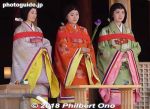
Iris flower offerings followed. Leading court ladies called the Myobu (命婦), assistants who tend to the immediate needs of the Saio princess. 献花の儀式Apr 26, 2020
|
|

Flower offering by court ladies called Nyoju (女嬬) who serve in the inner palace (後宮) and take care of the Saio princess' daily living. Apr 26, 2020
|
|
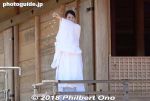
The Departure Ceremony started with a purification ritual called "Kiyone no Gishiki." A woman at two corners of the Seiden sprinkled confetti. 清めの儀式Apr 26, 2020
|
|

After the festival is over, be sure to visit the Saiku Historical Museum nearby. See this album.Apr 25, 2020
|
|
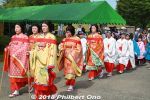
Court ladies called Nyoju (女嬬). Apr 25, 2020
|
|
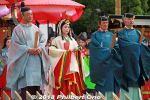
The man on the far right in dark blue is Ise Kokushi (伊勢国司) Governor of Ise Province. Next to him also in blue is the Chobusoshi (長奉送使) director of the Saio procession.Apr 25, 2020
|
|
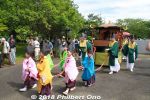
Aristocratic boys wearing a Heian-Period suikan costume. 童男人形「水干」Apr 25, 2020
|
|
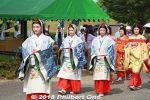
High-ranking court ladies called Uneme (釆女) chosen from an aristocratic family. They were in charge of food and drink for the princess.Apr 25, 2020
|
|
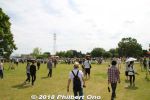
As the Saio procession went through the park, the crowd followed. 上園芝生広場Apr 25, 2020
|
|
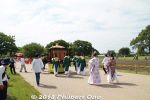
Apr 25, 2020
|
|

Today, Meiwa is a sleepy little town bypassed by most tourists going to Ise or Toba. Official Saiku infoApr 20, 2020
|
|

Saiku Station on the Kintetsu Yamada Line.Apr 20, 2020
|
|

Saiku Station on the Kintetsu Yamada Line.Apr 20, 2020
|
|

Saiku Station on the Kintetsu Yamada Line which is the same train line that goes on to Ise-shi (Ise Grand Shrines) and Toba Station (Mikimoto Pearl Island).Apr 20, 2020
|
|

The Saiku area is a Japan Heritage site and this Ise road has been renovated.Apr 20, 2020
|
|

The Saiku area is a Japan Heritage site.Apr 20, 2020
|
|
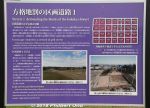
Meiwa town has been excavating Saiku Palace digs all over the place. They found pillar holes, pottery, etc. The digs will continue for many more years. Relics are displayed in the local museum. Apr 20, 2020
|
|

The train line cuts right across the Saiku site.Apr 20, 2020
|
|

Shinden shrine buildings for religious services.Apr 20, 2020
|
|

About the Nai-in, the living quarters of the Saio princess. 内院Apr 20, 2020
|
|

The Nai-in block was enclosed by a pillared fence. 内院Apr 20, 2020
|
|

An outdoor 1/10-scale model of the Saiku Palace site (700 m x 2 km) was created near the Saio Woods. It had a grid layout of blocks as shown here. The site included buildings for the Saikuryo Government that govenred the Saiku Palace.Known blocks are labeled like here. The trees in the background in this photo shows the Saio Woods where the princess lived.Apr 20, 2020
|
|

Apr 20, 2020
|
|

Ryoko storehouses of the Saikuryo government.Apr 20, 2020
|
|

They also have a scale model of the palace with many buildings over a wide area.Apr 20, 2020
|
|

The Saiku was a lost palace and its exact location was unknown until 1970 when the land here was being prepared for a housing project. Ancient pottery pieces and remains of building foundations were unearthed.In fact, local residents for generations had passed down the story of the palace being located here. In 1903, a local group led by the Saiku village headman erected this stone monument from recognize Saiku as the palace site. It wasn't until June 1970 when remains of the Saiku Palace were found in Meiwa.Apr 20, 2020
|
|

Inside Itsuki Chaya rest house and gift shop. Posters of past Saio in past Saio Festivals. いつき茶屋Apr 20, 2020
|
|

Itsuki Chaya rest house and gift shop. いつき茶屋Apr 20, 2020
|
|

Opened in Oct. 1999, Itsukinomiya Hall for Historical Experience is in the same area. Various hands-on activities like weaving and dressing in Heian-Period costumes. Open 9:30 am–5 pm, closed Mondays. Admission free. いつきのみや歴史体験館Apr 20, 2020
|
|

About Saiku Heian-no-mori Park. Open 9:30 am to 5 pm (until 4 pm during Nov.–Feb.). The buildings are aso available for rent for private events.Apr 20, 2020
|
|

The Higashiwakiden is only partially walled with an earthen floor, used as a waiting room or preparation room during ceremonies. 東脇殿Apr 20, 2020
|
|

This main building is the Seiden dating from the 9th century used to conduct important ceremonies by the head of the Saikuryo and to welcome official messengers from Ise Grand Shrines and Kyoto.Normally open to the public, free admission. 正殿Apr 20, 2020
|
|

The Nishiwakiden is thought to be an auxiliary to the Seiden and used for rituals and banquets. 西脇殿Apr 20, 2020
|
|

Saiku Heian-no-mori Park recreates one of the many rectangular blocks of the Saiku Palace area. This one reconstructs three buildings used by the head of the Saikuryo, the government office of the Saiku Palace. The left building is the Nishiwakiden, center is Seiden (main building), and right building is the Higashiwakiden. The buildings are only approximations of what they actually looked like. Only the size could be determined from pillar holes, but not the actual apperance. This is where the Saio Matsuri festival's Departure Ceremony is held.Apr 20, 2020
|
|

Saiku Heian-no-mori Park (さいくう平安の杜) opened in Oct. 2015 with three reconstructed buildings.Apr 20, 2020
|
|

The actual road where the Saio princess traveled to Ise Grand Shrines. Called "Kodai Ise-do" (Ancient Ise Road). 古代伊勢道Apr 20, 2020
|
|

The actual road where the Saio princess traveled to Ise Grand Shrines. Called "Kodai Ise-do" (Ancient Ise Road). 古代伊勢道Apr 20, 2020
|
|

Sign saying "Saiku" which was designated as a National Historic Site in 1979. 国史跡Apr 20, 2020
|
|

Everyone quickly dissipated and all the food stalls closed up. It was only 3:30 pm.Apr 20, 2020
|
|
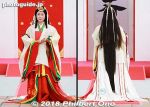
In the end, the Saio princess slowly walked through the palace door that opened for her. Her long, black hair and way of walking were very elegant. After she entered, the doors closed and the festival was over.Apr 20, 2020
|
|

The Saio princess wears a juni-hitoe (12-layer) robe reserved only for female Imperial family members or women marrying into the Imperial family.Apr 20, 2020
|
|
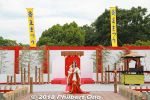
Yellow banners read "Saio Matsuri" (Saio Festival).Apr 20, 2020
|
|
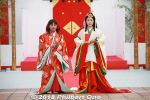
Child Saio princess and adult Saio princess.Apr 20, 2020
|
|
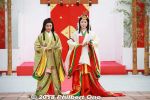
Posing with the Nyo-betto (女別当) who was the supervisor of the court ladies at special occasions such as the Saio procession. Apr 20, 2020
|
|
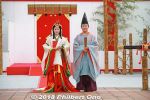
Posing with the Emperor's Messenger who is the highest ranking person in the procession. (Konoe Tsukai). 近衛使Apr 20, 2020
|
|
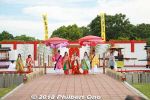
Posing with top-ranking court ladies called the Naishi (内侍) working at the Saiku Palace. They have fancy umbrella bearers called furyu-gasa. 風流傘Apr 20, 2020
|
|
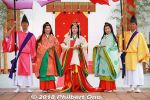
Posing with top-ranking court ladies called the Naishi (内侍) working at the Saiku Palace. They have fancy umbrella bearers called furyu-gasa. 風流傘Apr 20, 2020
|
|
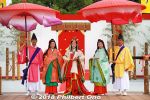
Posing with top-ranking court ladies called the Naishi (内侍) working at the Saiku Palace. They have fancy umbrella bearers called furyu-gasa. 風流傘Apr 20, 2020
|
|
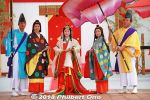
Posing with top-ranking court ladies called the Naishi (内侍) working at the Saiku Palace. They have fancy umbrella bearers called furyu-gasa. 風流傘Apr 20, 2020
|
|
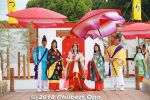
Posing with top-ranking court ladies called the Naishi (内侍) working at the Saiku Palace. They have fancy umbrella bearers called furyu-gasa. 風流傘Apr 20, 2020
|
|
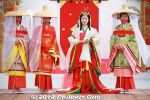
Posing with leading court ladies called the Myobu (命婦), assistants who tend to the immediate needs of the Saio princess.Apr 20, 2020
|
|
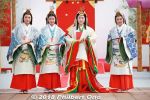
Posing with court ladies called the Uneme (釆女) chosen from an aristocratic family and who was in charge of food and drink.Apr 20, 2020
|
|
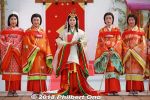
Posing with court ladies called Nyoju (女嬬) who serve in the inner palace (後宮) and take care of the Saio princess' daily living.Apr 20, 2020
|
|
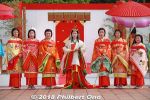
Posing with court ladies called Nyoju (女嬬) who serve in the inner palace (後宮) and take care of the Saio princess' daily living.Apr 20, 2020
|
|
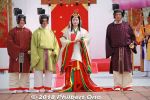
Kadono-osa, the security detail. They hold a tachi sword. 看督長Apr 20, 2020
|
|
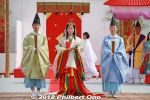
Saiku government officials. 斎宮十二司官人Apr 20, 2020
|
|

Saiku government officials. 斎宮十二司官人Apr 20, 2020
|
|
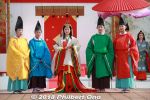
Posing with dancers called Maibito (舞人).Apr 20, 2020
|
|
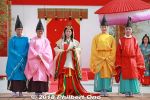
Posing with dancers called Maibito (舞人).Apr 20, 2020
|
|

Posing with Saio palanquin bearers called Kayocho (駕輿丁) who were chosen from the best gentlemen.Apr 20, 2020
|
|

Posing with Saio palanquin bearers called Kayocho (駕輿丁) who were chosen from the best gentlemen.Apr 20, 2020
|
|
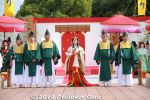
Posing with Saio palanquin bearers called Kayocho (駕輿丁) who were chosen from the best gentlemen.Apr 20, 2020
|
|
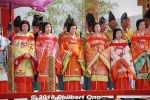
Ladies wearing a red band across their shoulders are court ladies called Nyoju (女嬬) who serve in the inner palace (後宮) and take care of the Saio princess' daily living.Apr 20, 2020
|
|
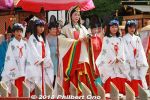
Saio posing with Warawame (童女) dressed in chihaya costume. 千早Apr 20, 2020
|
|
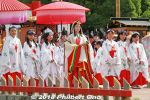
After the arrival ceremony, they held a picture-taking session with the Saio princess who posed with each group of characters. Anyone could take pictures. This was a great PR strategy. Obviously, social media fodder. Got some good photos of everyone.Apr 20, 2020
|
|
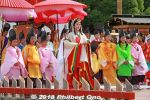
Saio posing with Warawame (童女) dressed in Heian-Period suikan costume. 水干Apr 20, 2020
|
|

Posing with Meiwa's mascot Mei-hime. めい姫Apr 20, 2020
|
|

Before the Saio moves or poses, her attendants arrange her juni-hitoe kimono.Apr 20, 2020
|
|
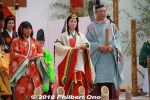
Apr 20, 2020
|
|
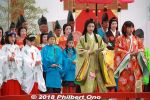
In green, Nyo-betto and the Child Saio princess.Apr 20, 2020
|
|
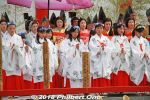
Warawame (童女) daughters of the Imperial family or nobility. They wear chihaya costume. 千早Apr 20, 2020
|
|
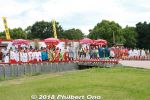
Everyone arrived here and the ceremony started with a few speeches.Apr 20, 2020
|
|
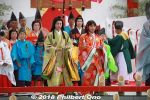
In green is the Onna Betto (or Nyo-betto) (女別当) who was the supervisor of the court ladies at special occasions such as the Saio procession. Apr 20, 2020
|
|

On this outdoor stage, they were to hold the Shato-no-Gi welcome ceremony at 2:50 pm when head honchos give speeches. 社頭の儀. This is the Saikuryo Government Director General. 斎宮寮長官Apr 20, 2020
|
|

Apr 20, 2020
|
|

Almost an hour later, the procession arrived at this park with this outdoor stage for the welcome ceremony. The Saio arrived.Apr 20, 2020
|
|
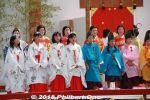
Girls called Warawame (童女). They are children of the Imperial family or nobility and are learning the customs of the Saiku while living in the Saiku Palace. Apr 20, 2020
|
|
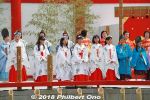
Girls called Warawame (童女) wearing chihaya costume 千早. They are daughters of the Imperial family or nobility and are learning the customs of the Saiku while living in the Saiku Palace. Apr 20, 2020
|
|
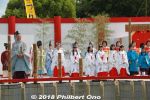
They started gathering on the outdoor stage near the Saiku Historical Museum.Apr 20, 2020
|
|

High-ranking court ladies called Uneme (釆女) chosen from an aristocratic family. They were in charge of food and drink for the princess.Apr 20, 2020
|
|

Court lady called the Uneme (釆女) chosen from an aristocratic family and who was in charge of food and drink.Apr 20, 2020
|
|

The procession walked through a lawn of food stalls and headed for the outdoor stage. This is near the Saiku History Museum.Apr 20, 2020
|
|

Naishi (内侍) coordinator of court ladies in Saiku Palace. She has a fancy umbrella bearer called furyu-gasa. 風流傘Apr 20, 2020
|
|

Child Saio princess. 子供斎王Apr 20, 2020
|
|

Child Saio princess. 子供斎王Apr 20, 2020
|
|

Apr 20, 2020
|
|

Saio princess in a palanquin in Meiwa, Mie Prefecture.Apr 20, 2020
|
|

Saio princess in a palanquin in Meiwa, Mie Prefecture.Apr 20, 2020
|
|

Saio princess in a palanquin in Meiwa, Mie Prefecture. The Saio princess was selected from tens of candidates. This was her fourth time to apply for the honor and she was finally selected.It is to promote the town so she was very willing to pose for pictures. The makeup person did a very good job.Apr 20, 2020
|
|

Saio princess in a palanquin in Meiwa, Mie Prefecture. Very photogenic makeup and costume.Apr 20, 2020
|
|

Saio princess in a palanquin in Meiwa, Mie Prefecture.Apr 20, 2020
|
|

This is the Saio princess sitting in a palanquin on wheels. In Saiku, the Saio's palanquin is called Sokaren (葱華輦), meaning "Onion Flower Palanquin" in reference to its onion-shaped giboshi roof ornament.The Saio palanquin bearers are called Kayocho (駕輿丁) who were chosen from the best gentlemen.Apr 20, 2020
|
|

In front of the Saio princess palanquin are girls are called Warawame (童女). They are daughters of the Imperial family or nobility and are learning the customs of the Saiku while living in the Saiku Palace. Apr 20, 2020
|
|

Girls called Warawame (童女) wearing chihaya costume 千早. Part of the festival route was the actual route where the Saio princess traveled to Ise Grand Shrines.Apr 20, 2020
|
|

Naishi (内侍) coordinator of court ladies in Saiku Palace. She has a fancy umbrella bearer called furyu-gasa. 風流傘Apr 20, 2020
|
|

Naishi (内侍) coordinator of court ladies in Saiku Palace. They have a fancy umbrella bearer called furyu-gasa. 風流傘Apr 20, 2020
|
|

Apr 20, 2020
|
|

Myobu (命婦), assistants who tend to the immediate needs of the Saio princess.Apr 20, 2020
|
|

The first palanquin carries the Nyo-betto (女別当), the supervisor of the court ladies.Apr 20, 2020
|
|

The first palanquin carries the Nyo-betto (女別当), the supervisor of the court ladies.Apr 20, 2020
|
|

In front of the Saio princess palanquin are girls are called Warawame (童女). They are daughters of the Imperial family or nobility and are learning the customs of the Saiku while living in the Saiku Palace. They wear chihaya costume. 千早Apr 20, 2020
|
|

Nyoju (女嬬) followed by Warawame (童女) daughters of the Imperial family or nobility.Apr 20, 2020
|
|

Ladies wearing a red band across their shoulders are court ladies called Nyoju (女嬬). Apr 20, 2020
|
|

High-ranking court ladies called Uneme (釆女) chosen from an aristocratic family. They were in charge of food and drink for the princess.Apr 20, 2020
|
|

Apr 20, 2020
|
|

Apr 20, 2020
|
|

Apr 20, 2020
|
|

Apr 20, 2020
|
|

The Saio Gunko Procession started at around 2 pm.Apr 20, 2020
|
|

The Saio princess procession (斎王群行) had about 120 people dressed in Heian Period (794–1185) costumes.Apr 20, 2020
|
|
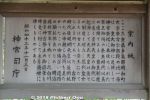
Saio Woods explanation as of 1968.Apr 20, 2020
|
|

Saio Woods 斎王の森Apr 20, 2020
|
|

In the Saio Woods, Historic Site marker for the Saiku Palace. The Saiku Palace was constructed anew for each new Saio. 斎王の森Apr 20, 2020
|
|

About the Saio Woods.Apr 20, 2020
|
|

Stone monument in the Saio Woods indicating the location of the Saiku Palace. "Site of the Saio Palace" erected in On Nov. 3, 1968.斎王の森Apr 20, 2020
|
|

On Nov. 3, 1968, Ise Jingu Shrine erected this stone monument in the Saio Woods to indicate that the Saiku Palace was located in this area.斎王の森Apr 20, 2020
|
|

Torii in Saio Woods. 斎王の森Apr 20, 2020
|
|

Patch of trees are the Saio Woods where the Saiku Palace was supposedly located. 斎王の森Apr 20, 2020
|
|

Saio Matsuri banners were put up by local jr. high students.Apr 20, 2020
|
|

Irises in early June in Meiwa, Mie Prefecture. Meiwa's official flower. Ancient texts mention that pilgrims going to worship at Ise Shrines described it like walking on clouds of purple.Apr 20, 2020
|
|

Until the 19th century, wild irises grew extensively in Saiku's natural wetlands. A National Natural Monument, Saiku/Ise irises are one of Japan's few natural iris strains from which hybrids were created. Wetlands have been recreated in Saiku to grow irises.Apr 20, 2020
|
|

The procession is about to leave the starting point at around 2 pm. Purple irises is another symbol of Meiwa, probably why they hold the festival in June.Apr 20, 2020
|
|

Palanquins for the Saio (middle), Nyo-betto, and Child Saio standby for the procession. The orignal palanquins had no wheels.Apr 20, 2020
|
|

After the Departure Ceremony, the Saio exits showing her long, flowing black hair.Apr 20, 2020
|
|

Saio princess gave a farewell speech.Apr 20, 2020
|
|

Saio Matsuri Departure Ceremony at Seiden Hall, Saiku Heian-no-mori Park. 正殿Apr 20, 2020
|
|

Nara Period (8th century) sacred dance (舞樂蘭陵王).Gagaku music was performed by Kogakkan University's Gagaku club seen in the background. 皇學館大学 雅楽部Apr 20, 2020
|
|

Ranryo-o court dance dating to the Nara Period (8th century). Chinese warrior Ranryo-o was Prince of Lanling (Gao Changgong), a victorious 6th c. general. (舞樂蘭陵王).To hide his gentle-looking face, Ranryo-o wore a fierce mask in battle. Notice the dragon head mask.Apr 20, 2020
|
|

Ranryo-o court dance originally came from China and was a warrior hero dance. (舞樂蘭陵王).Apr 20, 2020
|
|

The departure ceremony included live gagaku sacred music and a Nara Period (8th century) sacred dance called Ranryo-o. (舞樂蘭陵王). Gagaku music was performed by Kogakkan University's Gagaku club. It's a Shinto university in Ise. 皇學館大学 雅楽部Apr 20, 2020
|
|

In 2018, the Saio princess was portrayed by 26-year-old Nakaho Yuri (中保 友里) from Tsu, Mie. She was selected from among 27 applicants. It was her fourth time to apply for this honor and was finally selected. It's confusing that she's called the 34th Saio at the 36th Saio Matsuri. It's because the festival didn't have a Saio from the 1st festival. She served well.Apr 20, 2020
|
|

The Saio princess wears a juni-hitoe (12-layer) robe reserved only for Imperial family members. Apr 20, 2020
|
|

The Saio princess appeared from the Seiden and gave an offering of an iris flower and prayed toward Ise Grand Shrines.The Saio was an unmarried, young Imperial princess, often the Emperor's daughter, who was appointed (by divination) to be the High Priestess of Ise Grand Shrines to pray for national peace and prosperity a few times a year in place of the emperor.Apr 20, 2020
|
|

Everyone here are volunteers, includng the festival staff behind the scenes. The festival is directed by a group (named Komachi 小町) of former Saio princesses and other characters who train the current year's festival participants.Apr 20, 2020
|
|

Ladies wearing a red band across their shoulders are court ladies called Nyoju (女嬬) who serve in the inner palace (後宮) and take care of the Saio princess' daily living.Apr 20, 2020
|
|

Top-ranking court ladies called the Naishi (内侍) working at the Saiku Palace.In green is the Onna Betto (or Nyo-betto) (女別当) who was the supervisor of the court ladies at special occasions such as the Saio procession. Apr 20, 2020
|
|

In 2018, the child Saio princess was portrayed by 10-year-old Nishimura Manami (西村 まなみ) from Meiwa. She was selected by lot from a number of girls. Not all Saio princesses were adults, some were a child. 子供斎王Apr 20, 2020
|
|

Naishi (内侍) and the Nyo-betto leads the Child Saio princess.Apr 20, 2020
|
|

Top-ranking court ladies called the Naishi (内侍) working at the Saiku Palace.Apr 20, 2020
|
|

Top-ranking court ladies called the Naishi (内侍) working at the Saiku Palace.Apr 20, 2020
|
|

Top-ranking court ladies called the Naishi (内侍) working at the Saiku Palace.Apr 20, 2020
|
|

Court ladies called Nyoju (女嬬) who serve in the inner palace (後宮) and take care of the Saio princess' daily living.Apr 20, 2020
|
|

High-ranking court ladies called Uneme (釆女) chosen from an aristocratic family. They were in charge of food and drink for the princess.Apr 20, 2020
|
|

High-ranking court ladies called Uneme (釆女) chosen from an aristocratic family. They were in charge of food and drink for the princess. They give an iris flower offering.Apr 20, 2020
|
|

Myobu (命婦) getting off the Seiden.Apr 20, 2020
|
|

Myobu (命婦) getting off the Seiden.Apr 20, 2020
|
|

Dancers called Maibito (舞人).Apr 20, 2020
|
|

Saiku government officials. 斎宮十二司官人Apr 20, 2020
|
|

People wore Heian Period (794–1185) costumes from when Kyoto was the capital of Japan. These are Saiku government officials. 斎宮十二司官人Apr 20, 2020
|
|

Large crowd sitting on the tarp and watching the departure ceremony. It's pretty hot under the sun.Apr 20, 2020
|
|

The Departure Ceremony at Saiku Heian-no-mori Park gathered all the people in traditional costume. 出発式Saiku Heian-no-mori Park (Saiku Heian Era Park) recreates one of the many rectangular blocks of the Saiku Palace area. This one reconstructs three buildings used by the head of the Saikuryo, the government office of the Saiku Palace. This main building is the Seiden (正殿) dating from the 9th century used to conduct important ceremonies by the head of the Saikuryo and to welcome official messengers from Ise Grand Shrines and Kyoto. Saio Matsuri is a tourist/community festival, not a religious festival held by any shrine. Run by a volunteer committee.Apr 20, 2020
|
|
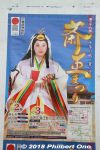
Meiwa holds the two-day Saio Matsuri (斎王まつり) festival annually on the first full weekend in June to reenact part of the Saio procession traveling from Kyoto to the Saiku Palace.On June 2–3, 2018, the 36th Saio Matsuri was held in Meiwa. It also happens to be the town's 60th anniversary. The festival is held near Saiku Station (Kintetsu Yamada Line) in the area where the Saiku Palace was located. It's now a large park-like area. On the festival's first day (Festival Eve) at 3:30 pm, the Misogi-no-Gi Ceremony is held at a small stream where the Saio dips her hands into the water for purification. Then they move to an outdoor stage near Saiku History Museum to conduct an evening ceremony and entertainment program from 5 pm to 9 pm. (In the case of rain, the event will be canceled.)Apr 20, 2020
|
|

On the second day, the Departure Ceremony is held here at the Saiku Heian-no-mori Park where a few Heian Period structures have been reconstructed. They had a large blue tarp on the ground for spectators.Second day is the main event. There's the Departure Ceremony and Saio Gunko Procession. The Departure Ceremony reenacts the Saio's departure from Kyoto for her journey to Saiku Palace.
At 1 pm, the Departure Ceremony is held at Saiku Heian-no-mori Park where a few Heian-Period buildings have been reconstructed. At 2 pm, the 120 people dressed in Heian-Period costumes walk in a colorful procession called the "Saio Gunko" to an outdoor stage near the Saiku History Museum. The Saio princesses are carried in their own palanquins. It's a short walk.
On the outdoor stage, they hold a ceremony and picture-taking session from 2:45 pm. Everything ends by 3:30 pm. I went to see the festival on the second day on June 3, 2018. In the case of rain, the event will be canceled.
If you want to get close, you need to arrive earlier than the 1 pm starting time. Short walk from Saiku Station.Apr 20, 2020
|
|

Meiwa is a rural town (pop. 22,500) next to Ise and the site of the Saiku Palace (斎宮) where the Ise Jingu Grand Shrines' High Priestess (Saio princess) resided during the 7th–14th centuries to conduct ceremonies at Ise in place of the emperor.The Saio princess was an unmarried, young Imperial princess closely related to the Emperor, usually a daughter or sister. She was appointed (by divination with a turtle shell that was burnt) to be the High Priestess of Ise Grand Shrines to represent the emperor when conducting official ceremonies at the shrine a few times a year to pray for national peace and prosperity. Each time a new emperor was enthroned, a new Saio princess was appointed as the High Priestess and she traveled from Kyoto to live in the Saiku Palace in Meiwa. The journey, called "Saio Gunko," took 5 nights and 6 days through Kyoto and Shiga Prefectures and her entourage was several hundred. For about 660 years from 673 to 1334, over 60 Saio princesses served at Ise Grand Shrines. Many of them were age 5 to 15, and the oldest was 32. They served for varying periods of time, from 1 to 31 years. The High Priestess conducted prayers at the shrine for the peace, protection, welfare, and prosperity of the nation. As this sign indicates, Meiwa and Saiku is a Japan Heritage Site.Apr 20, 2020
|
|

Saiku is also known for ancient burial mounds (kofun) or tsukayama. This one is near the history museum. 塚山2号墳Apr 20, 2020
|
|
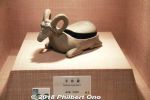
Apr 20, 2020
|
|
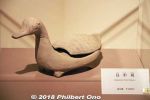
Apr 20, 2020
|
|
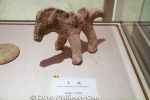
Doba (clay horse figurine)Apr 20, 2020
|
|
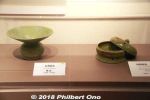
Green-glazed pottery used in Saiku. Apr 20, 2020
|
|
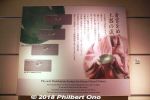
Green-glazed potteryApr 20, 2020
|
|
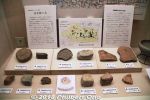
Saiku roof tile fragments.Apr 20, 2020
|
|
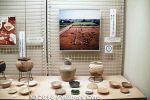
Pottery found at the Saiku site.Apr 20, 2020
|
|

The fall and abolishment of the Saiku.Apr 20, 2020
|
|

Saiku buildings.Apr 20, 2020
|
|
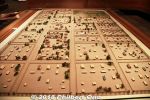
Scale model of of the Saikuryo Government area where the Saio resided in Saiku. A large spread of administrative buildings, storehouses, and shrines. 斎宮寮 復元模型 1/400 Today, archaeological digs continue at this site. An area 2 km by 700 meters has been designated as a National Historic Site.Apr 20, 2020
|
|
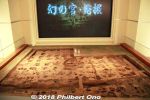
Scale model of a Saiku archaeological excavation. 発掘調査区模型(20分の1)Apr 20, 2020
|
|
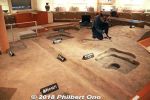
In 1970 when they surveyed the land for a housing project in Meiwa, they finally discovered the remains of the Saiku Palace. In 1979, the site was designated as a National Historic Site. Reconstruction of a Saiku archaeological excavation.Apr 20, 2020
|
|
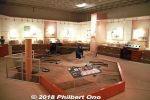
Exhibition Room 2 centers on Saiku archaeological excavations and artifacts. Here's a reconstruction of a Saiku dig. 常設展示室IIApr 20, 2020
|
|

History of the Saio.Apr 20, 2020
|
|
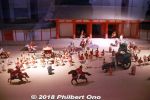
Model of Saio Gunko procession. In its heyday, there were as many as 500 people in her procession.Apr 20, 2020
|
|
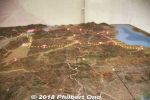
The Saio princess and her entourage of several hundred traveled from Kyoto (left in photo) to Ise in five nights and six days, about 130 km. Along the way, they lodged at Seta (Otsu), Koka, Tarumi (Tsuchiyama), Suzuka, and Ichishi before arriving in Saiku.Apr 20, 2020
|
|

Route of the Saio Gunko procession.Apr 20, 2020
|
|

About the Saio procession.Apr 20, 2020
|
|

Faith and purity in Saiku. The Saio princess was not allowed to fall in love. How cruel...Apr 20, 2020
|
|

The Saio princess officiated important ceremonies at Ise Grand Shrines only three times a year.Apr 20, 2020
|
|

Selection and isolation of the Saio princess.Apr 20, 2020
|
|
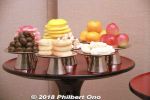
Saio’s mealsApr 20, 2020
|
|
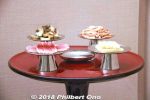
Saio’s mealsApr 20, 2020
|
|
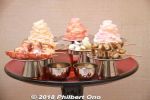
Saio’s mealsApr 20, 2020
|
|
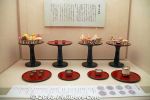
Saio’s meals.Apr 20, 2020
|
|

Apr 20, 2020
|
|

Apr 20, 2020
|
|
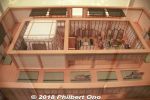
Top view of living quarters of the Saio princess. 斎王御殿 復元模型 1/15 Apr 20, 2020
|
|
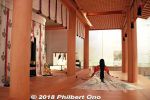
Apr 20, 2020
|
|
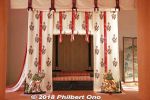
Sleeping quarters for Saio princess.Apr 20, 2020
|
|
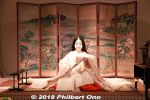
Saio princess in her living quarters (dining room). She wears a white juni-hitoe kimono, formal clothing used in ceremonies. 斎王の居室Apr 20, 2020
|
|
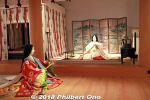
Living quarters of the Saio princess. Woman in front is the Myobu, the Saio’s first lady-in-waiting. 斎王の居室Apr 20, 2020
|
|
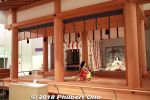
Living quarters of the Saio princess in the 11th century. 斎王居室復元模型Apr 20, 2020
|
|
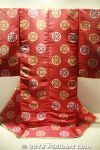
Saio princess kimono.Apr 20, 2020
|
|
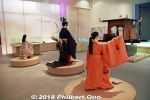
Apr 20, 2020
|
|

About the aristocratic boy's Heian-Period suikan costume. 童男人形「水干」Apr 20, 2020
|
|
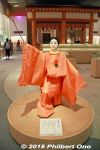
Aristocratic boy wearing a Heian-Period suikan costume. 童男人形「水干」Apr 20, 2020
|
|
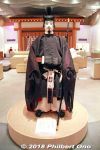
Government official wearing a Heian-Period sokutai costume. 武官人形「束帯」Apr 20, 2020
|
|
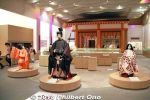
Aristocratic boy wearing a Heian-Period suikan costume. 童男人形「水干」, Government official wearing a sokutai costume. 武官人形「束帯」, and aristocratic girl wearing akome costume. 童女人形「衵」Apr 20, 2020
|
|

Saio princess procession.Apr 20, 2020
|
|

About the Saio princess' Sokaren palanquin. The roof has a decoration that looks like an onion flower. Apr 20, 2020
|
|
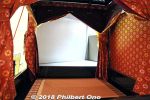
Saio princess palanquin called "Sokaren." 斎王の神輿「葱華輦」Apr 20, 2020
|
|
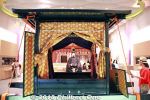
Saio princess palanquin called "Sokaren." 斎王の神輿「葱華輦」Apr 20, 2020
|
|
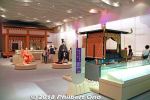
Exhibition Room 1 shows Saiku Palace- and Saio princess-related artifacts. Costumes, reconstructed Saio living quarters, and a few mannequins. 常設展示室IApr 20, 2020
|
|
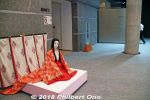
Museum greeter (non-human).Apr 20, 2020
|
|

Museum floor plan. There are two Exhibition Rooms, lecture hall, theater, library, and coffee shop.Apr 20, 2020
|
|

Museum entrance hall.Apr 20, 2020
|
|

Saiku History Museum (officially and incorrectly named "Saiku Historical Museum") is a 15-min. walk through the park from Saiku Station on the Kintetsu Yamada Line.Apr 20, 2020
|
|
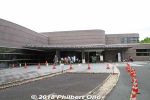
Opened in Oct. 1989, the Saiku History Museum (officially and incorrectly named "Saiku Historical Museum") is located on the former site of the Saiku Palace. Open 9:30 am to 5 pm. Closed Mon. and Dec. 29–Jan. 3.
Admission ¥340 (Free for kids)Apr 20, 2020
|
|

Jun 18, 2017
|
|

Jun 18, 2017
|
|

Jun 18, 2017
|
|

About the well.Jun 18, 2017
|
|

A well remaining at Toba Castle.Jun 18, 2017
|
|

Jun 18, 2017
|
|

About Toba Castle's main tenshu tower.Jun 18, 2017
|
|

Jun 18, 2017
|
|

Site of Toba Castle's main tower.Jun 18, 2017
|
|

Jun 18, 2017
|
|

Jun 18, 2017
|
|

About Toba Castle.Jun 18, 2017
|
|

Jun 18, 2017
|
|

About the castle wall.Jun 18, 2017
|
|

The only castle wall remaining at Toba Castle.Jun 18, 2017
|
|

Jun 18, 2017
|
|

Jun 18, 2017
|
|

Toba CastleJun 18, 2017
|
|

Way to the Honmaru.Jun 18, 2017
|
|

About Shiroyama Park at Toba Castle.Jun 18, 2017
|
|

Shiroyama Park at Toba Castle.Jun 18, 2017
|
|

Shiroyama Park at Toba Castle.Jun 18, 2017
|
|

Shiroyama Park at Toba Castle.Jun 18, 2017
|
|

Toba Castle site is on a small hilltop overlooking Mikimoto Pearl Island.Jun 18, 2017
|
|

Jun 18, 2017
|
|

Part of the castle site is Shiroyama Park with nice views of the pearl island. Jun 18, 2017
|
|
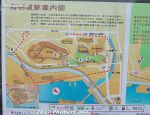
Only a few stone walls and a well remain. No buildings. It was once the administrative center for the Toba Domain. The last occupants was the Inagaki Clan.Jun 18, 2017
|
|

Jun 18, 2017
|
|

Go up these stairs for Toba Castle.Jun 18, 2017
|
|

Toba StationJun 18, 2017
|
|

Toba Castle is a short walk from Toba Station.Jun 18, 2017
|
|

Scenic views on the way to Toba.Jun 18, 2017
|
|

Toba StationJun 18, 2017
|
|

Toba StationJun 18, 2017
|
|

JR Toba StationJun 18, 2017
|
|

Gift shop at Toba Station.Jun 18, 2017
|
|
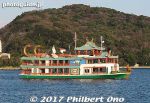
Boat for Dolphin Island.Jun 18, 2017
|
|

Ticket booth for boat rides to nearby Dolphin Island.Jun 18, 2017
|
|

Rock garden outside Mikimoto Kokichi Memorial HallJun 18, 2017
|
|

Jun 18, 2017
|
|

Jun 18, 2017
|
|

Jun 18, 2017
|
|

Jun 18, 2017
|
|

Jun 18, 2017
|
|

Mikimoto Kokichi Memorial HallJun 18, 2017
|
|

Jun 18, 2017
|
|
| 1114 files on 5 page(s) |
2 |  |
 |
|